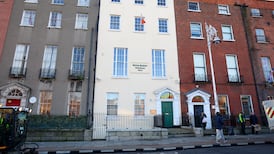There is a new school of thinking when it comes to setting up a study centre in the home, says Barry Rochford of Danish design company BoConcept, which has shops in Beacon South Quarter and Arnotts. The quality of the fit-outs at the Dublin headoffices of tech giants Google and Facebook are the greatest influencers for the tween and teen generations.
Designed not to impress their customers but rather their employees, many of whom are fresh out of college, he makes the argument that a cool work environment with an aspirational feel will generate positive connotations that will boost productivity.
“School kids want to emulate those kind of work spaces at home,” Rochford says. They want a real life-like office environment to study in, agrees Ikea Dublin interior designer Igor Valigura.

The Swedish giant’s Jules chair (€30), an adjustable junior desk design that comes in pink, blue or white, is a good starting point for any study set-up.
The issue of study space is important. It’s one that interior designer Philippa Buckley of Studio 44 brings up with clients of even very small children. When her own kids were young they worked at the dining table where there was room to spread the books out.
Colonising a formal dining room as a study centre is one option if you can keep the kids quiet and not distracted, she says, but where possible Buckley prefers to incorporate some form of desk into a child’s bedroom or integrate study areas, ideally one for each child, into the playroom.
It’s a smart idea that will pay dividends, says Gabrielle Lennon of Flexa, a Scandinavian brand of children’s furniture based in Blackrock, Co Dublin.
“Setting up a work space in the playroom is a really smart option especially if you can get your child to enjoy drawing and colouring at the desk. They will then associate the desk with play and the transition to doing homework at it will feel more natural.”
A formal desk is a purchase usually made by parents of tweens – kids aged between 10 and 11 upwards – she notes, “when they realise that the kitchen table isn’t sufficiently quiet to knuckle down to work”. All the desks at Flexa are adjustable to fit all ages. Several have been designed for use in small spaces and some can even be attached to Flexa beds so you can study in the tiniest of rooms.
The best study environments start with a fixed daily routine, says Orla Ní Shuilleabhain of the Institute of Education's study skills department and author of Study Skills and Exam Techniques.
“By studying in the same place every day you create a mental association with this location as a place of concentration and effective study. By effectively managing time and helping your children to set study goals you are equipping them with skills that they can use in life.”
Parental involvement to help structure routine helps create a discipline that will stand to them, she says.
A decluttered space helps kids focus on study. Cable management boxes help declutter desk space for older kids, Howard’s Storage World stock clip (€11.95) and boxes (€34.95) will untangle spaghetti junctions. A tablet or laptop support is another smart investment and also works for those moments when the kids want to work while slouching on the sofa. Ikea’s Brada support board costs €3.50 or invest in a set of feet to prop your device at a good working angle. HSW sells a set of four for €22.99.
Study time should be tech free, advises Ní Shuilleabhain. “One of the big problems now is that children entering secondary school suffer from a lack of concentration and are unable to sit quiet.”
Minimising social media and tech time will help them learn to focus – a valuable asset in life, she says.
It may be old school but a notice board still has a role to play. In a digital age it becomes a place they can put class and extra curricular activity timetables – not just for their attention but for parents too.
A clock helps kids understand how much time their homework is taking them to do. While it is essential for exam-stage students it also helps younger children focus and prioritise.
Ikea’s Pladdra clock (€15) has a blackboard face that can help teach younger kids to tell the time and also to understand the concept of time and completing homework tasks within a certain timeframe, Ní Shuilleabhain says.
The room rules
Learning how to study is not just important for the Junior and Leaving Cert, but will stand to students for the rest of their lives. Some of the benefits include:
– Being able to adapt to new environments and change in existing areas, whether in the workplace or at home.
– Understanding how to prioritise within a task list and achieve goals within a set period .
– Knowing how to focus in order to achieve a task that requires strong concentration.
– Being more open to making new friends and establishing important relationships.
– Opening their minds to new experiences and learning opportunities, and especially to fully develop their natural abilities.
Creating the optimum study environment
–You need a desk, comfortable chair and good lighting and heating when necessary
– Avoid clutter.
– Minimise distractions by insisting that phones are turned off and used during breaks only.
– Have daily/weekly planners in place where they can be seen. Encourage the student to check off completed tasks/study periods as they finish them.
Optimum Desk Height and Chair Type
A child’s desk should allow:
– The student’s feet to rest flat on the floor
– When seated at the desk with hands placed on top of the desk, the student’s elbows should be open at an angle of 90 to 110 degrees
– If you cannot adjust the desk height of the desk, try using an adjustable height chair with good lumbar support.
Task Lighting
– Optimum task lighting, in the form of under-shelf lighting or portable floor or desk lamps, will help students complete homework more effectively and study without tiring as quickly.
– Try using a high-powered, but warmer-coloured bulb to make the study area feel more attractive to the student. The light needs to be bright enough to prevent eyes getting tired.











